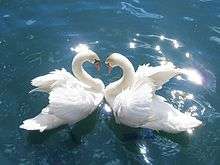Paramahamsa
Paramahamsa (परमहंस), also spelled paramahansa or paramhansa, is a Sanskrit religio-theological title of honor applied to Hindu spiritual teachers who have become enlightened. The title literally means "supreme swan," and symbolizes spiritual discrimination. The swan is equally at home on land and on water; similarly, the true sage is equally at home in the realms of matter and of spirit. To be in divine ecstasy and simultaneously to be actively wakeful is the paramahansa state; the 'royal swan' of the soul floats in the cosmic ocean, beholding both its body and the ocean as manifestations of the same Spirit. The word 'Paramahamsa' signifies one who is Awakened in all realms.[1] Paramahansa is the highest level of spiritual development in which a union with ultimate reality has been attained by a sannyasi.[2]

Etymology
Paramahamsa is a Sanskrit word translated as 'supreme swan'. The word is compounded of Sanskrit परम parama meaning 'supreme' or 'transcendent' (from PIE per meaning 'through', 'across', or 'beyond', cognate with English far) and Sanskrit हंस hamsa meaning 'swan or wild goose'. The prefix parama is the same element seen in Parameshwara, a title for God. Early English scholars of Indian language and religion may have mockingly translated hamsa as 'goose' in particular, because in English folklore a goose (the domesticated type) traditionally denotes foolishness and irresponsibility. But in Hindic tradition, wild geese, including swans, are noted for characteristics of discipline, stamina, grace, and beauty. This is especially said of the bar-headed goose (Anser indicus), whose migratory route from Central Asia to India and back forces it to fly over the Himalayas twice a year, a feat which makes it one of the highest flying birds in the world.[3]
Hamsa may be a religious pun or allegory with a philosophical meaning. One such etymology suggests that the words 'aham' and 'sa' are joined to become 'hamsa'; aham is 'I' or 'me' and sa is 'he', together meaning 'I am he'. Here, 'I' refers to the jivatma or jivatama, the living soul, and 'he' the paramatma or paramatama or supreme soul (the alternative spellings are due to differing Romanisations of the Sanskrit words). This relationship reflects of Advaita philosophy, which advocates the oneness of jivatma and paramatma. The word aham is common to many Eastern religions. From aham is derived ahamkara or ego.
Mythology
The hamsa (swan) is the vahana, the mount or vehicle, of the god Brahma. In the Vedas and the Purânas it is a symbol for the soul/Soul. The hamsa is said to be the only creature that is capable of separating milk from water once they have been mixed; symbolically this is the display of great spiritual discrimination. It is symbolic for a spiritually advanced being who is capable of controlling the breath energy in such a way that he only absorbs pure vibrations from all the different energies the world contains. To the Paramahamsa (the supreme celestial Swan) on the other hand, the whole of creation is God himself, there is nothing else but God alone. This person is a fully realized soul, completely liberated from all bonds with the world, who knows no obligations, no likes or dislikes. He is without any needs because he is completely immersed in God.
Theology
Paramahamsa, as a religio/theological title, is applied to an adept class of Hindu renunciates, liberated, realized masters who, having attained the supreme yogic state, or nirvikalpa samādhi, can always distinguish between the Real (sa) from the unreal (ham).
The hamsa mantra indicates the sound made by the exhalation ("ha") and inhalation ("sa") of the breath.
Privileged use
Some followers believe title cannot be assumed by oneself, but must be conferred by a recognized authority, either another individual swami who is himself esteemed as enlightened, or by a committee of spiritual leaders.
Other meaning
Paramahaṃsa is also the title of one of the Upanishads.[note 1]
Paramahamsa title personalities
- Abhiram Parmahansa
- Chandradhoja Paramahansa Dev
- Dayanidhi Paramahansa Dev
- Lahiri Mahasaya
- Narayana Guru
- Nigamananda Paramahansa
- Paramahamsa Hariharananda
- Paramahamsa Prajnanananda
- Paramahamsa Vishwananda
- Paramahansa Yogananda
- Paramhansa Acharya Yogiraj Balkrishananda 'Mukta-Buddha'
- Paramhansa Nikhileshwarananda
- Paramhansa Swami Niranjanananda Saraswati
- Paramhansa Swami Satyasangananda Saraswati
- Paramhansa Swami Satyananda Saraswati
- Ramakrishna Paramahansa
- Sadanand ji Paramhansa
- Shivdharmanand Paramahansa
- Srimad Durga Prasanna Paramahansa Dev
- Swami Sri Yukteswar*
- Kalna Paramhansa
- Sivananda paramahamsa vadakara
Notes
- In Sanskrit, a pre-consonantal nasal is written with a diacritic dot (the Anusvara) above the preceding character. The exact realization of the nasalization must be inferred from the context. Thus, we have Paramahaṃsa, Paramahamsa, Paramahaṇsa, and Paramahansa as equivalent transliterations.
References
- Yogananda, Paramahansa. God Talks with Arjuna - The Bhagavad Gita. Self-Realization Fellowship 1995, ISBN 0-87612-030-3.
- "Merriam-Webster Dictionary". Retrieved 2012-06-21.
- Than, Ker (June 10, 2011). "Highest Flying Bird Found; Can Scale Himalaya: The Bar-headed Goose Can Reach Nearly 21,120 Feet, New Study Shows". National Geographic News. Washington, DC, US: National Geographic Society. Archived from the original on February 1, 2013. Retrieved February 15, 2013.
External links
- Hindu lexicon
- Hindu glossary
- Hamsa - The Bar-headed Goose, Anser indicus